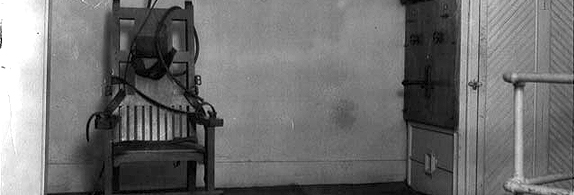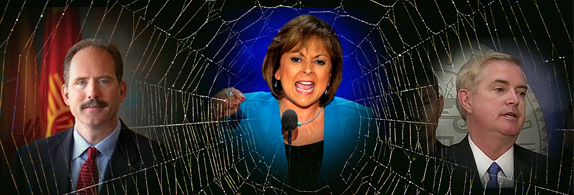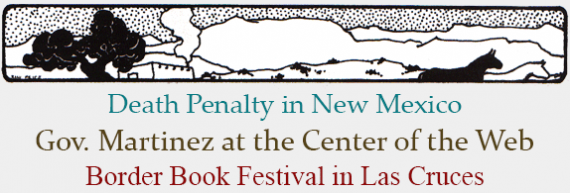Death Penalty in New Mexico

The unconscionable brutality of the execution of Clayton Lockett in Oklahoma last week puts New Mexico’s abolition of the death penalty in 2009 in humanitarian perspective. Our home state joins l8 other states and 140 countries in doing away with capital punishment.
One of the central moral tenants of western civilization is that taking a human life is forbidden. “Thou shalt not kill.” It is probably the most disrespected and violated of all the admonitions underlying civil and compassionate behavior. Still, it exists as a bedrock insight into maintaining a society that citizens can trust.
If taking a human life is a fundamental crime, then the sacred nature of each human being is a fundamental value.
Naively, I use to think that if a government abolished the death penalty, its officials and its policies might come to view human life as something to be cherished and nurtured, and certainly never violated by unconstitutional lethal force. But New Mexico’s abolition of the death penalty seems to have had no impact on the policies or tactics of the Albuquerque Police Department or the State Police since its enactment in 2009. In fact the killing ratio has grown in an opposite direction: Twenty five civilian deaths at the hands of police in Albuquerque since 2009 compared to data that I have over a nine year period from l987 to l996 in which the APD killed 30 people, most of them not involved in major violent crimes. A full list of the killing of civilians by police here is being assembled from various sources.
Albuquerque can frequently be a dangerous place, but now the police have taken up the job of public executioner. The terrible reality is, however, that the people killed by these officers would never have received a death sentence in a court of law, not even in New Mexico before 2009. Most of the victims were people guilty of unruly behavior, mentally ill people, or those struggling with addiction. They were not serial killers, not gang warlords, not armed bank robbers, not cop killers, not violent rapists, not muggers with weapons, nor hired assassins. Mary Hawkes, l9, was a homeless girl who might or might not have been involved in the theft of a truck. She was said to have had a gun, an accusation her friends say is preposterous. No weapon has been produced other than a “replica” of the gun she was supposed to have had. Now she is dead, shot by a police officer. And more than a week and a half later, neither the APD leadership nor the mayor have supplied any more information on the murder.
Even if abolishing the death penalty hasn’t sent humanitarian reverberations through Albuquerque and other New Mexico communities it is one of the great acts of political courage and moral steadfastness in my experience.
The move to abolish executions started some six years after what many think was the worst, and among the most violent prison riots in the history of the United States. Thirty-three inmates died, most at the hands of their peers, 200 were injured, and 12 prison guards were kidnapped. None of the guards were killed, but seven were beaten and raped. The New Mexico State Pen was a harsh place. On the wall in the Warden’s conference room was plaque that I first thought was a Boy Scout project on knot tying. When I took a second look as a young reporter, I saw that it was a kind of trophy board, with little rope frames circling photographs of the people executed in the pen’s death chamber. That same day we were given a tour of the gas chamber, last used in l960.
On Thanksgiving eve l986 Governor Toney Anaya commuted the death sentences of five men, convicted of murder, to life in prison without parole. It was an unparalleled act of bravery and conscience by a New Mexico politician in a state which, at the time, still favored the death penalty by 75%.
In a news conference at the Round House Anaya said “Let us put an end to this macabre national death march. It is inhumane, immoral, anti-God, and is incompatible with an enlightened society.”
Twenty eight years later 140 countries around the world agree with him including Canada, Mexico, South Africa, Great Britain, France, Norway, Cambodia, and Germany. Anaya faced harsh criticism during the last days of his term in December 1986 from Republicans and Democrats alike. And the death penalty itself was not abolished and replaced with a life term without possibility of parole until 2009 when Governor Bill Richardson signed an anti-capital punishment bill into law. He said at the time, “The sad truth is the wrong person can still be convicted in this day and age, and in cases where that conviction carries with it the ultimate sanction, we must have ultimate confidence, I would say certitude, that the system is without flaw or prejudice. Unfortunately, this is demonstrably not the case.” When Richardson signed the bill, 64% of New Mexicans agreed with the ending the death penalty.
Between Gov. Anaya’s heroic stand and Gov. Richardson’s act of responsive conscience, another execution was carried out in New Mexico. Terry Clark was put to death by lethal injection in November 2001. He was the only inmate executed between the reinstatement of the death penalty in New Mexico in l976 and its abolition in 2009. The U.S. Supreme Court had ruled in l972 that the death penalty was unconstitutional, but then reversed itself in cases of aggravated murder in l976.
Terry Clark was executed by lethal injection during the administration of Gov. Gary Johnson, a strong advocate of the death penalty but one who eventually changed his mind. Clark confessed to the rape and murder of nine-year old Dena Lynn Gore of Artesia in l986. Clark pled guilty to first degree murder in hope of having a death sentence commuted by Governor Anaya. But a district judge refused to start sentencing proceedings until after Anaya had left office. Early in l987 a jury in Tucumcari sentenced Clark to death. In l994 the New Mexico Supreme Court found that the Tucumcari jury had wrongly applied the law and Clark was retried in Silver City in l996. Despite former Governor Anaya’s testimony that he would have commuted Clark’s death sentence too, a Silver City jury imposed the death penalty. Clark himself stopped his appeals process in 1999 and was executed some two years later.
In October 2001 before Clark’s execution, which Governor Johnson refused to stop, Johnson wrote that “I am of the opinion that swift and sure punishment deters crime. Currently, I do not believe that New Mexico’s death penalty serves as an effective preventative measure because it is neither swift nor sure.” He said he thought “the time period currently allowed for appeals is too long and yet I have come to believe that innocent people might be put to death if these safeguards are not in place.”
A recent estimate of innocent people on death row in the United States is 4.1%. The legal “niceties” and technicalities that keep that ultimate injustice from actually being carried out is at the heart of the humane conscience of our legal system. Taking an innocent life is seen by the courts, as it rightly should be, as the most heinous miscarriage of justice possible.
The same view is not held, apparently, by police shooters and their superiors on the streets of Albuquerque.
At the Center of the Web

I won’t call Governor Martinez a black widow, but she does sit in the center of a web of callousness that stretches across the state.
Take Albuquerque Police Chief Gordon Eden. He is as direct an appointment of the governor as you can find, without actually being one. The governor’s co-ideologist Albuquerque Mayor Richard Berry, appointed Eden as the APD’s top cop. And he is now in charge of a police department that still refuses to release information on the police killing of a l9 year old homeless girl, even though the whole city is waiting for some truth to be told. That’s the same mayor who has apparently disconnected his cell phone so no one can find him in his bunker.
Make no mistake. Chief Eden – the guy who said the killing of James Boyd in the Sandia Foothills was “justified” -- is the governor’s man. Governor Martinez said when Eden was chosen chief, “I strongly support Gordon Eden taking this position and believe he is an excellent choice to be the next chief of the Albuquerque Police Department. Gordon is a strong leader in New Mexico in our continuing efforts to keep New Mexico safe.” Eden is the former cabinet Secretary for Public Safety in the Martinez administration.
Let’s hear it for keeping “New Mexico safe.” But safe from what? Freedom of Speech? This is the same governor whose operatives flagrantly offended the First Amendment by trying to muscle a TV station last week into not running an opposition ad with a young Hispanic woman saying that the governor played along with her staff when they laughed and shamed Spanish speaking families, “like mine.” Martinez’s people threatened groundless accusations of libel, in an attempt to scare off the station with the threat of a SLAPP-like lawsuit. SLAPP means Strategic Lawsuit Against Public Participation. But folks caught on fast. Read the excellent coverage of the matter in the May 2, 2014 edition of New Mexico Politics with Joe Monahan for a full run down on this disgraceful attempt at censorship.
And this is the Republican governor that the national Democratic Governor’s Association (DGA), a huge campaign funder, won’t put up any money to help defeat in November because it says it believes her opponents can’t win! Heavens to Mergatroid! IF you’re not going to help New Mexico, at least keep your big mouth shut about it.
Does the DGA’s cutting and running from this vital contest guarantee the governor’s victory in November? Not at all. I think it will just make deserted New Mexicans who oppose the governor redouble their efforts. And really, if you want an easy pickin’s candidate to oppose, you couldn’t ask for a bigger fluffball than the governor.
She’s dissed so many communities, so many networks, so many New Mexicans it’s hard to imagine how the DGA could have misread the situation here. Didn’t they talk to anyone? Teachers and their vast connections will rise up against her. Behavior health specialists will too. Environmentalists will go to the mat to get her and her Copper Rule Environment Secretary out of the Round House. The GLBT community will too. I can’t imagine that anyone concerned about water woes and climate change will vote for a governor who comes from a party that denies climate change and has done nothing at all about New Mexico’s water planning needs. And who in their right minds can say the governor has helped New Mexico’s economy when we’re still scraping the bottom of the barrel in income, growth, and child welfare categories nearly four years into her watch? And how could anyone forget that four years ago, governor wannabe Martinez received the enthusiastic endorsement of Sarah Palin?
I don’t think even all the dirty tricks of voter suppression and intimidation will keep the anti-Martinez voter turnout down. It’s my feeling her opponents will flood the polls, wade through storms, and hack through red tape wherever it’s found just so they can vote.
They will have seen through the claims that she balanced the budget in tough times. She has a constitutional mandate to balance the budget. She has no choice. They will catch on to her defunding of social services to the needy to the tune of nearly $67 million dollars. It won’t take Mother Jones magazine to remind them of her association with the underbelly of Republican politics and New Jersey Governor Chris Christy and his looming political disaster called Bridgegate, although Mother Jones has helped. Calling two term New Mexico Lt. Governor Diane Denish a “bitch” will doom her bid for many crossover votes.
And, in one of the stupidest political ploys in decades around here, Martinez’s people concocted a scabrous, dare I say “libel-like” guilt by association campaign against Democratic Gubernatorial candidate Alan Webber for associating with Mark Rudd, the long ago anti-war activist and longtime community college math teacher and all around good man who probably has more friends in New Mexico than all of Martinez’s people combined. These absurd innuendos caused the Webber camp to fire off the first really sizzling retort in the whole election season, citing the dubious histories of the governor’s closest advisors and prompting many to give a cheer, hoping that a political prize fighter had actually stepped into the ring.
But let’s not forget that New Mexico’s lackluster Democrats couldn’t defeat New Mexico governor Gary Johnson when he ran for reelection in l998. One of the worst governors in the history of the state, serving from l995 to 2003 as a libertarian do-nothing, Johnson was the guy who vetoed more bills than all other governors combined in his first year in office, and once proposed building a prison in boiling hot Hobbs that didn’t have air conditioning to save on costs. Wise advisors who remembered the specter of the State Penitentiary riot in 1980 apparently dissuaded him.
We know the Albuquerque Journal will endorse Martinez again and claim she has the best plans for the state when she has no plans at all to build anything but only to demolish what’s left after her first term. We know it endorsed Mayor Berry when it fully aware of his wretched record with the police department. We know it endorsed Gary Johnson in l998 and helped to defeat Marty Chavez.
Defeating Susana Martinez this year should be a no-brainer. We’ll see after the June 3rd primary if local democrats still know how to win. But how could having New Mexico still be number one in childhood hunger in an election year help a sitting governor get re-elected? Hasn’t her own record already delivered a knockout punch?
Border Book Festival

Driving down to Las Cruces through Hatch past massive pecan groves, huge ocean green fields of onions, cruising along beside what looks like an utterly desiccated river in the middle of the scraggy beauty of southern New Mexico, one could almost forget for a moment about what many of us feel are the mean streets of Albuquerque.
The destination was the 20th annual Border Book Festival in Las Cruces, co-founded by New Mexico’s great playwright, novelist, translator, short story writer and nurturer of community Denise Chavez, and biologist and writer Susan Tweit. The festival had moved this year from Old Mesilla to the Mesquite Historic District, part of the Camino Real in the heart of old Las Cruces. And there it will stay.
This year the festival was called “Maiz: Honoring the Corn Mother,” the great giver and sustainer of life. In a world full of unkindness and violence, the Corn Mother and the warm, creative community of the festival reminded us all once again how relationships in this world can be -- if a loving spirit prevails.
With musicians, performers, and painters from Mexico, poets and chefs from New Mexico, voices for Guatemala and Chile and many others, the Corn Mother Festival was ecumenically rich, beautiful in spirit with welcoming abrazos of compassionate civility. The wind whipping through Kline Park and up and down Mesquite street in the Historic District from the Sunshine Market built in the l850s to Nopalitos Gallery and Café, was literally a breath of the future, clearing out what clogs up life – the insensitivity, hardheartedness, and cynicism of the present – and blowing in an open-hearted attentiveness that made everyone feel at home. Give a look at the Border Book Festival website, it will give you a full run down and perhaps inspire you to attend next year’s festival.
Some of the many empowering moments at the festival were numerous school visits by artists and writers from New Mexico and Latin America. In an email, Denise Chavez wrote that “We were told at Hermosa Heights Elementary that our group was the first group of Spanish speakers EVER to come to their school and visit classrooms. Remember that we are only 42 miles from the Mexican border and that New Mexico is an official English/Spanish bilingual state. “
“No one knew,” she continued, “the power of the school outreach program and how it would reflect back to our community’s need. May this be a comienzo/a beginning to heal our splintered community. How wonderful it was to see students going back and forth in English and Spanish and those speaking English or Spanish sharing with their classmates without a stigma of ‘them or us’.” For those of us who are not quite monolingual, being immersed at times in the magnificent sounds of Spanish brought new meanings, new recognitions, and a deeper desire than ever to cease being monolingual at all.
The new home of the Border Book Festival is an elegantly plain New Mexico building a block away from Kline Park called Casa Camino Real. The Festival is also working on creating a Museo de la Gente in the Mesquite area. It will be a place, Chavez writes, with a performance space, an art gallery and a borderland archival library, a place where “people from our diverse multicultural community of the Border can find respect, good will, and creativity.”
If you want to become a member of the Festival, you are welcome to join on the website.




Responses to “Provincial Matters, 5-6-2014”